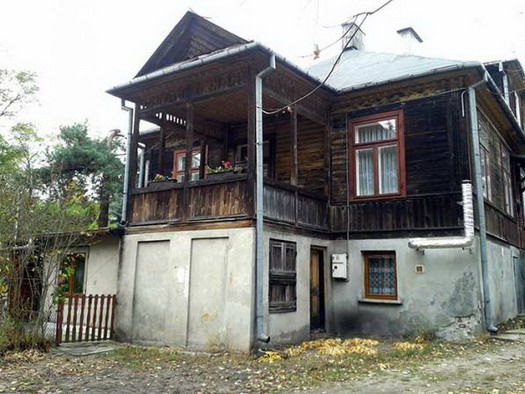
Found: Home of Chabad Yeshiva in Otwock, Poland
A rookie researcher from S. Paulo, Brazil, made it her goal to locate the once glorious building of the Lubavitch Yeshivah school, known as Tomchei Tmimim, in Otwock, Poland.
Sila Rosenfeld, an independent publisher and researcher, traveled to Poland numerous times in recent years. She became interested in Jewish Poland after her parents died;her father was a Holocaust survivor and her mother immigrated to Brazil in 1936. At the time she studied Polish at the Polish consulate in S. Paulo, and in 2009 she went on a three week language immersion trip to Poland where she visited her father’s shtetl, Dzialoszyce.
During her travels from Warsaw to Krakow, Sila happened upon the small town of Otwock, pronounced Otvotzk.
“My guide, Robert Sieradzki, asked if we would like to see the town and the Jewish cemetery,” she recalled. “It was a town in the middle of the pine woods, 12 miles south from Warsaw. He wanted to show me the beautiful houses in świdermajer style where Jewish families lived.”
Eventually, Sila learned that there was a Chabad center in the town before WWII that was used until the first Nazi bombardment of the Jewish area. Herself once a student at a Chabad seminary, she visited Lubavitch World Headquarters in Brooklyn, New York in 1980, where she met the Lubavitcher Rebbe. Hence her interest in exploring Chabad’s roots.
Otwock was a vacation area for many Chasidic Jews. It was also the base of Chabad-Lubavitch operations in Europe for many years prior to WWII. The sixth Chabad Rebbe, the Rabbi Joseph I. Schneersohn, spearheaded some two dozen schools in Europe, Israel and many more in the Former Soviet Union, all from his office in Otwock.
So with the address Slowackiego 1 in hand, she made her way to the city. Alas, “all I found was an empty piece of land,” she said.
For the next few years, Sila was bothered: could it be that the entire school building was actually demolished while all the homes in the vicinity were still standing?
“I looked at the pictures of the neighboring homes, I looked at Google Earth, and still couldn’t find any answers. Maybe the houses changed numbers?”
Rabbi Shalom Ber Levine, author of Toldot Chabad b’Polin, [The History of Chabad in Poland], and chief librarian of the Chabad-Lubavitch Library, did extensive research on that era and location. He and other researchers believed that the building did not exist anymore.
“The building was built from wood and presumably did not survive since it was abandoned in 1939,” said Levine, explaining why no one looked for it until now.
Last month, on her third trip to Poland, Sila decided to do some more research. Her efforts were well-rewarded when she learned that at some point, the city changed the address, and it was now Slowackiego 22. With that, she made her way back to the town.
Photos from the building reveal the surrounding gardens and trees where students would relax, study or spend hours in contemplative prayer. Sila had her eureka moment: “I could not believe my eyes when I saw the house from outside.”
According to Sila, the building was owned by the city until it was recently sold. Call it serendipity, or better, call it Providence, while she was there, the owner, who leases the property to tenants, showed up and offered to give Sila a tour of the inside.
“We went inside and I felt like it was all a dream. Here we are in the study hall, the living space, the balcony, where thousands of students studied until the Nazis destroyed Jewish life in Poland,” she told lubavitch.com.
The interior of the building has since been renovated and the structure reinforced, but all the exterior details remain unchanged.
“I feel that all my visits to Poland were worth this discovery.”





























amazing story
A fusion of past and present.
Jason
there are no interior photos?
Crown Heights Resident
I wonder if chabad could get a lawyer to file a lawsuit to have the building restored to chabad
Then they could rebuild the Yeshivah for European chabad Bochrim to learn in Tomchei Tmimim, in Otwock, Poland.
Chossid
@CH Resident.
Why not put in an offer and buy it? Given the length of time I would assume the current owner paid someone for this property and wasn’t the one who seized it.
Price
Probably cheaper to buy than to win a lawsuit.
yashar koach
this is the most amazing story ever.